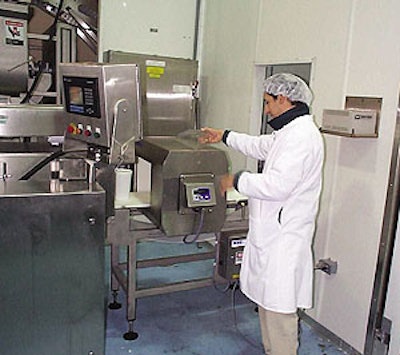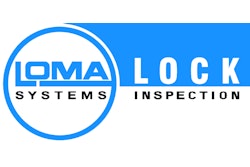At Hans Kissle’s Wilmington, MA, plant, six metal-detection systems from Lock Inspection Systems (Fitchburg, MA) added a year ago inspect 5- and 10-lb tubs of lobster, macaroni, coleslaw, potato, and other salads. Hans Kissle needed metal detection systems that could accommodate the different types of salad yet not have a drop-off in sensitivity or efficiency.
All six of Lock’s MET 30+ metal detectors incorporate Lock’s ADC software. Combined with Lock’s Heavy Duty conveyors, they provide Hans Kissle with a more user-friendly approach to product inspection than when two previously used metal detectors were relied on.
“The key factor that convinced us to choose Lock’s equipment was that it presents all the advantages of up-to-date digital technology, but in an easy-to-use format,” says Mary Connolly, vp of operations at Hans Kissle.
The MET 30+ can memorize profiles for as many as 100 products and automatically adjust the parameters of the metal detector for each product. However, Hans Kissle only uses it to memorize 10 to 12 salad types per packaging line. This user-friendly aspect was one of the three core reasons behind the purchase of the Lock machines. Excellent customer service and Lock’s nearby location are the other two reasons, Connolly says.
Because Hans Kissle’s workforce consists of varied education levels and different languages, the new ADC diagnostic software was a crucial addition to the metal detection system. Regardless of the education level and language an operator speaks, he or she can be trained to access the on-screen diagnostic tools to identify and resolve problem areas and to simplify data analysis.
The software enables operators to view signals from the detector that are translated into graphical format on the PC screen. Data, including records of rejects, can then be printed for on-site analysis of system problems or transferred via network or modem for remote servicing and diagnostics.
“It is important that our line lead people use the machines too, not just our quality control staff,” Connolly says. “Because quality control personnel can’t be everywhere at once, and quality is part of everyone’s job description in our plant.”
All six detectors are mounted on Lock’s Heavy Duty stainless-steel conveyors that withstand daily washdowns at the plant.
In the plant
Capable of inspecting 30 to 40 tubs/min, the six metal detectors, one of which is a recently added combination detector and checkweigher, can be moved as necessary to operate on any of Hans Kissle’s seven packaging lines. Product is conveyed to the detectors from a filler/lidder.
An operator first calibrates the machine based on product type. It’s an important step because some products, because of their salt and moisture content, have conductive properties that will set off the metal detector’s alarms. If, however, the metal detector is properly calibrated according to product type, the product’s conductive properties are effectively tuned out.
The detector searches for both ferrous and nonferrous metal. If metal is detected, the machine rings and the belt conveyor stops. A tool-less changeover is required when Hans Kissle switches the container size. A total of five different sizes are handled.
According to Connolly, metal detectors all serve the same function. She believes the difference is the Lock machine’s simplicity. “Anyone who’s familiar with metal detectors is going to want to use one that’s user friendly,” she says. “[Detectors] are simply a box that rings, and they are very much a mystery to most people. We like things that are simple and easy to operate.”
The purchase of the machines proved to be a substantial acquisition for the food manufacturer. “Purchasing new inspection equipment represents a considerable investment, so we couldn’t afford to get it wrong,” she says. “We have not been disappointed. With the benefits of installation outweighing the initial cost of investment, the MET 30+ metal detection systems have paid for themselves through increased uptime.” —ALR



























